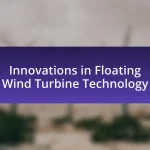The article focuses on enhancing safety protocols in offshore wind projects through the integration of advanced technologies. It outlines current safety measures, including rigorous risk assessments, regular training, and the use of monitoring technologies such as drones and IoT devices. The development and implementation of these protocols involve stakeholder consultation and adherence to regulatory standards, which are crucial for minimizing risks associated with offshore operations. Additionally, the article discusses the role of data analytics and predictive maintenance in improving safety decision-making, as well as the challenges and future trends in adopting innovative technologies to further enhance safety in this sector.
What are the current safety protocols in offshore wind projects?
Current safety protocols in offshore wind projects include rigorous risk assessments, regular safety training for personnel, and the implementation of advanced monitoring technologies. These protocols are designed to mitigate hazards associated with offshore operations, such as extreme weather conditions and equipment failures. For instance, the use of drones and remote sensors enhances real-time monitoring of turbine conditions, allowing for proactive maintenance and reducing the risk of accidents. Additionally, adherence to international safety standards, such as those set by the International Electrotechnical Commission, ensures that safety measures are consistently applied across projects.
How are these safety protocols developed and implemented?
Safety protocols in offshore wind projects are developed through a systematic process that involves risk assessment, stakeholder consultation, and adherence to regulatory standards. Initially, a comprehensive risk assessment identifies potential hazards associated with offshore operations. This assessment informs the creation of protocols tailored to mitigate identified risks. Stakeholder consultation, including input from engineers, safety experts, and regulatory bodies, ensures that the protocols are practical and compliant with industry standards. Implementation occurs through training programs, regular drills, and the integration of technology, such as monitoring systems and communication tools, to enhance safety measures. The effectiveness of these protocols is often validated through audits and continuous improvement processes, ensuring they remain relevant and effective in addressing emerging safety challenges.
What role do regulatory bodies play in shaping these protocols?
Regulatory bodies play a crucial role in shaping safety protocols for offshore wind projects by establishing standards and guidelines that ensure operational safety and environmental protection. These organizations, such as the International Maritime Organization and national regulatory agencies, develop regulations based on research, industry best practices, and safety assessments. For instance, the European Union’s Offshore Renewable Energy Strategy outlines specific safety measures that member states must implement, thereby influencing the protocols adopted in offshore wind projects across Europe. This regulatory framework is essential for minimizing risks associated with offshore operations, ensuring compliance, and promoting technological advancements that enhance safety.
How do industry standards influence safety measures?
Industry standards significantly influence safety measures by establishing benchmarks for best practices and compliance requirements. These standards, such as those set by organizations like the International Organization for Standardization (ISO) and the American National Standards Institute (ANSI), provide guidelines that help ensure the safety of personnel and equipment in offshore wind projects. For instance, adherence to ISO 45001, which focuses on occupational health and safety management systems, can lead to a reduction in workplace incidents by promoting risk assessment and hazard control measures. This structured approach not only enhances safety protocols but also fosters a culture of safety within organizations, ultimately leading to improved operational efficiency and reduced liability.
Why is enhancing safety protocols crucial for offshore wind projects?
Enhancing safety protocols is crucial for offshore wind projects to protect workers and ensure operational efficiency. The offshore environment presents unique hazards, including extreme weather conditions and the complexities of working at sea, which can lead to accidents if safety measures are inadequate. According to the International Renewable Energy Agency, the offshore wind sector has seen a significant increase in investment, with global capacity reaching over 35 gigawatts in 2020, highlighting the need for robust safety protocols to manage the associated risks effectively. Enhanced safety protocols not only mitigate risks but also foster a culture of safety that can lead to improved project outcomes and reduced costs related to accidents and downtime.
What are the potential risks associated with offshore wind projects?
The potential risks associated with offshore wind projects include environmental impacts, technical failures, and economic uncertainties. Environmental impacts can arise from the disruption of marine ecosystems during construction and operation, potentially affecting local wildlife and habitats. Technical failures may involve issues such as turbine malfunctions or structural failures due to harsh marine conditions, which can lead to costly repairs and downtime. Economic uncertainties stem from fluctuating market conditions and the high initial investment required, which can affect the project’s financial viability. These risks highlight the importance of implementing robust safety protocols and advanced technologies to mitigate potential issues in offshore wind projects.
How can improved safety protocols mitigate these risks?
Improved safety protocols can mitigate risks in offshore wind projects by establishing standardized procedures that enhance worker safety and operational efficiency. These protocols include regular safety training, the use of advanced monitoring technologies, and strict adherence to regulatory compliance, which collectively reduce the likelihood of accidents and incidents. For instance, a study by the International Renewable Energy Agency (IRENA) found that implementing comprehensive safety management systems can decrease accident rates by up to 30%. By integrating technology such as real-time data analytics and automated safety checks, these protocols not only identify potential hazards but also facilitate timely interventions, thereby significantly lowering risks associated with offshore operations.
How can technology enhance safety protocols in offshore wind projects?
Technology can enhance safety protocols in offshore wind projects by integrating advanced monitoring systems, predictive analytics, and automated safety equipment. These technologies enable real-time data collection and analysis, allowing for immediate identification of potential hazards and timely intervention. For instance, the use of drones for inspections reduces the need for personnel to work at heights, significantly lowering the risk of accidents. Additionally, predictive analytics can forecast equipment failures before they occur, facilitating proactive maintenance and minimizing downtime. According to a report by the International Renewable Energy Agency, implementing such technologies can reduce operational risks by up to 30%, demonstrating their effectiveness in enhancing safety protocols.
What types of technology are currently being utilized?
Currently, various types of technology are being utilized in offshore wind projects to enhance safety protocols. These technologies include advanced monitoring systems, drones for site inspections, and predictive analytics for risk assessment. Advanced monitoring systems utilize sensors and IoT devices to continuously track equipment performance and environmental conditions, ensuring immediate response to potential hazards. Drones are employed for aerial inspections, allowing for safer and more efficient assessments of turbine structures and surrounding areas. Predictive analytics leverage data from past incidents and operational metrics to forecast potential safety risks, enabling proactive measures to be implemented. These technologies collectively contribute to improved safety and operational efficiency in offshore wind projects.
How do drones contribute to safety monitoring?
Drones significantly enhance safety monitoring by providing real-time aerial surveillance and data collection in offshore wind projects. They can quickly assess site conditions, monitor equipment integrity, and detect potential hazards, which is crucial for maintaining safety standards. For instance, a study by the European Union Aviation Safety Agency (EASA) highlights that drones can reduce inspection times by up to 80%, allowing for more frequent safety checks and timely interventions. This capability not only improves operational efficiency but also minimizes risks to personnel by reducing the need for them to work in potentially hazardous environments.
What is the role of IoT in real-time safety data collection?
The role of IoT in real-time safety data collection is to enable continuous monitoring and immediate reporting of safety conditions in offshore wind projects. IoT devices, such as sensors and wearables, collect data on environmental factors, equipment status, and worker health, transmitting this information instantaneously to centralized systems. This real-time data allows for prompt decision-making and risk mitigation, enhancing overall safety protocols. For instance, a study by the National Renewable Energy Laboratory highlights that IoT applications can reduce incident response times by up to 50%, demonstrating the effectiveness of IoT in improving safety outcomes in such high-risk environments.
How does data analytics improve safety decision-making?
Data analytics improves safety decision-making by providing actionable insights derived from large datasets, enabling organizations to identify potential hazards and mitigate risks effectively. For instance, in offshore wind projects, data analytics can analyze historical incident reports, weather patterns, and equipment performance to predict and prevent accidents. A study by the National Renewable Energy Laboratory found that predictive analytics can reduce operational downtime by up to 30%, demonstrating the tangible benefits of data-driven safety strategies.
What types of data are most valuable for enhancing safety?
The most valuable types of data for enhancing safety in offshore wind projects include real-time environmental data, equipment performance data, and incident reporting data. Real-time environmental data, such as wind speed, wave height, and weather conditions, allows for immediate risk assessment and decision-making to ensure worker safety. Equipment performance data, which tracks the operational status and maintenance needs of turbines and other machinery, helps prevent failures that could lead to accidents. Incident reporting data provides insights into past safety breaches, enabling organizations to identify patterns and implement preventive measures. Collectively, these data types contribute to a comprehensive safety management system that minimizes risks in offshore wind operations.
How can predictive analytics prevent accidents?
Predictive analytics can prevent accidents by analyzing historical data to identify patterns and potential risks before they lead to incidents. By utilizing algorithms and machine learning, predictive analytics can forecast equipment failures, human errors, and environmental hazards in offshore wind projects. For instance, a study by the National Renewable Energy Laboratory found that predictive maintenance can reduce downtime by up to 30%, thereby minimizing the risk of accidents associated with equipment failure. This proactive approach allows for timely interventions, enhancing overall safety protocols in offshore wind operations.
What are the challenges of integrating technology into safety protocols?
Integrating technology into safety protocols presents challenges such as resistance to change, high implementation costs, and the need for comprehensive training. Resistance to change often stems from employees’ reluctance to adopt new systems, which can hinder the effectiveness of safety measures. High implementation costs can strain budgets, particularly in offshore wind projects where investment in advanced technology is significant. Additionally, comprehensive training is essential to ensure that all personnel understand and can effectively use the new technology, which requires time and resources. These challenges are critical to address for successful integration and enhancement of safety protocols in offshore wind projects.
What barriers exist in adopting new technologies?
Barriers in adopting new technologies include high costs, resistance to change, lack of skilled workforce, and regulatory challenges. High costs can deter organizations from investing in new technologies, as initial expenditures may be significant. Resistance to change often stems from established practices and fear of the unknown, leading to reluctance among employees and management to embrace new solutions. The lack of a skilled workforce can hinder the effective implementation and operation of advanced technologies, as specialized training may be required. Regulatory challenges can also pose obstacles, as compliance with existing laws and standards may slow down the adoption process. These barriers collectively impact the integration of innovative technologies in enhancing safety protocols within offshore wind projects.
How do costs impact the implementation of safety technologies?
Costs significantly impact the implementation of safety technologies by determining the feasibility and scope of such initiatives. High initial investments can deter companies from adopting advanced safety measures, especially in capital-intensive sectors like offshore wind projects. For instance, a study by the National Renewable Energy Laboratory indicates that the upfront costs of safety technologies can range from thousands to millions of dollars, depending on the complexity and scale of the project. Consequently, budget constraints often lead organizations to prioritize essential safety upgrades over comprehensive technological solutions, potentially compromising overall safety effectiveness.
What training is required for personnel to effectively use new technologies?
Personnel require specialized training in the operation and maintenance of new technologies to effectively use them in offshore wind projects. This training typically includes hands-on workshops, simulations, and safety protocols specific to the technologies being implemented, such as turbine operation, data analysis software, and emergency response systems. For instance, a study by the National Renewable Energy Laboratory highlights that comprehensive training programs significantly reduce operational errors and enhance safety outcomes in wind energy projects.
How can these challenges be overcome?
To overcome challenges in enhancing safety protocols with technology in offshore wind projects, implementing advanced monitoring systems is essential. These systems utilize real-time data analytics and predictive modeling to identify potential hazards before they escalate. For instance, the integration of drones and IoT sensors can provide continuous surveillance of equipment and environmental conditions, significantly reducing the risk of accidents. Research by the National Renewable Energy Laboratory indicates that such technologies can improve incident response times by up to 30%, thereby enhancing overall safety.
What best practices can be adopted for successful technology integration?
Successful technology integration in offshore wind projects can be achieved by adopting best practices such as thorough planning, stakeholder engagement, and continuous training. Thorough planning involves assessing the specific technological needs and aligning them with project goals, ensuring that all necessary resources are allocated effectively. Stakeholder engagement is crucial, as involving all relevant parties—including engineers, safety personnel, and operators—facilitates smoother integration and addresses potential concerns early in the process. Continuous training ensures that all team members are proficient in using new technologies, which enhances safety and operational efficiency. These practices are supported by studies indicating that projects with comprehensive planning and stakeholder involvement experience fewer integration challenges and improved safety outcomes.
How can collaboration between stakeholders enhance safety technology adoption?
Collaboration between stakeholders enhances safety technology adoption by fostering shared knowledge, resources, and commitment to safety standards. When various stakeholders, such as project developers, regulatory bodies, and technology providers, work together, they can identify specific safety needs and tailor technology solutions accordingly. For instance, a study by the National Renewable Energy Laboratory highlights that collaborative efforts in offshore wind projects lead to improved risk assessments and the development of more effective safety protocols. This collective approach not only accelerates the integration of innovative safety technologies but also ensures that these technologies are widely accepted and effectively implemented across the industry.
What are the future trends in enhancing safety protocols with technology?
Future trends in enhancing safety protocols with technology include the integration of artificial intelligence (AI) for predictive analytics, the use of drones for real-time monitoring, and the implementation of wearable technology for worker safety. AI can analyze vast amounts of data to predict potential hazards, thereby allowing for proactive measures to be taken. Drones provide an efficient means of inspecting offshore structures, reducing the need for human presence in potentially dangerous environments. Wearable technology, such as smart helmets and vests equipped with sensors, can monitor vital signs and environmental conditions, alerting workers and supervisors to any safety concerns. These advancements are supported by industry reports indicating a significant reduction in accidents and improved response times in environments utilizing these technologies.
How is artificial intelligence expected to shape safety measures?
Artificial intelligence is expected to significantly enhance safety measures by enabling predictive analytics, real-time monitoring, and automated decision-making in offshore wind projects. These capabilities allow for the identification of potential hazards before they escalate, improving response times and reducing the likelihood of accidents. For instance, AI algorithms can analyze vast amounts of data from sensors and historical incidents to predict equipment failures, thereby facilitating proactive maintenance and minimizing risks. Additionally, AI-driven systems can monitor environmental conditions continuously, ensuring that safety protocols are adhered to in real-time, which is crucial in the dynamic offshore environment.
What innovations are on the horizon for offshore wind safety?
Innovations on the horizon for offshore wind safety include advanced monitoring systems, autonomous drones for inspections, and enhanced predictive maintenance technologies. These innovations aim to improve real-time data collection and analysis, allowing for quicker identification of potential hazards. For instance, the integration of Internet of Things (IoT) sensors on turbines can provide continuous monitoring of structural integrity, while drones equipped with high-resolution cameras can conduct visual inspections in hard-to-reach areas, reducing the need for human intervention in dangerous conditions. Additionally, predictive maintenance tools utilize machine learning algorithms to analyze historical data and forecast equipment failures, thereby minimizing downtime and enhancing overall safety.
What practical steps can be taken to enhance safety protocols in offshore wind projects?
To enhance safety protocols in offshore wind projects, implementing advanced monitoring systems is essential. These systems utilize real-time data analytics to track environmental conditions, equipment status, and personnel safety, thereby enabling proactive risk management. For instance, the integration of drones for site inspections can significantly reduce the need for personnel to work at heights, minimizing fall risks. Additionally, employing predictive maintenance technologies can identify potential equipment failures before they occur, thus preventing accidents. According to a report by the International Renewable Energy Agency, the use of digital technologies in offshore wind can improve safety outcomes by up to 30%.




